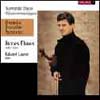|
The fiery strains of James Ehnes’ violin streak like the track of a fox moments ahead of Eduard Laurel’s piano as it unrolls the pastoral landscape of Smetana’s “From the Homeland: Two Pieces for Violin and Piano.” The shapely phrases of the first piece receive a beautifully modulated articulation with Laurel echoing the tonal flow of the singing voice of Ehnes’ violin. The piano introduces the second piece and the violin dramatically expands the sweep of large spaces (reminiscent of sections of the Moldau) where sprightly highlights of sunlight on water alternate with bold bravura strokes that shape the more rugged tones and shadowy features of the romantic landscape. The “virtuosic ending”, according to Guy Marchand’s liner notes, incorporates some of the edits that Ehnes and Laurel wrote into the original manuscript.
Ehnes’ technically flawless rendition of the Dvorák selections stand with the fine recorded performances given them by the contemporary masters, Perlman, Zhou and Stern, and Laurel’s sympathetic playing suggests a lucid and convincing partnership. The “Romantic Pieces, Op. 75” begins with violin and piano in unison uttering a heart-rendingly tender songlike theme, which receives full-bodied development. The second movement, originally titled ‘Capriccio’, is lively and dramatic, with piano and violin freely handing the melody back and forth between them as the mood alternates among weighty chords and light dancing phrases. The third piece is short—smooth, flowing ripples of piano behind a somewhat narrative exposition of a romantic theme by the violin. The final piece is elegiac. Ehnes’ violin adopts a smaller, more subdued voice, complaining in short phrases, repeated with slight variations, while Laurel’s left hand evokes darkening chords. In the finale, the energy rouses itself, the phrasing becomes longer and more flowing. This is a fearless performance, impressive in its range, intense and full of character.
Dvorák’s “Sonatina in G major, Op.100” is a delightfully happy piece, composed for his young son and daughter to play in celebration of their father’s return home after a nine month stay in America. Written in sonata form and developing a true dialogue between piano and violin, this piece shows the Ehnes/Laurel partnership at its very best. The mood of the first part is declamatory, moving in the second to slower, mournful feelings that come upon one almost like a liberation into sensitivity, which then flows through the last two movements into a rich, celebratory dance recalling Bruch’s “Scottish Fantasy.”
Janácek’s “Sonata for Violin and Piano”, his only composition in this genre, was 40 years in the making, premiering in 1921, six years before his death. If the “Romantic” is what this album is about, then Janácek brings the neurasthenic, melancholy, self-destructive face of Romanticism to the feast. Described in the literature by words like ‘fierce’, ‘vehement’, ‘troubled’ and ‘craggy-edged’, this piece shows the remarkable interpretive range of the Ehnes/Laurel duo, as they extend themselves into the mood of the ‘Late Romantic’, or ‘Modern’ period, the ‘Age of Anxiety’ of Stravinsky and Bartok. Here the moods of the violin could be catalogued as querulous, self-doubting, haunted, agonized, in-crisis, and freaked-out. The piece is built on short, repeated motifs, bolded by heavy-handed crashing piano chords and the high whistling tones of a violin at the end of its tether. The piece is reminiscent of the suicidal monologue of the heroine of Janácek’s lyric drama Katia Kabanova.
Nominated for a Juno in the category Classical Album of the Year: Solo or Chamber Ensemble. Recommended without reservation.
|


